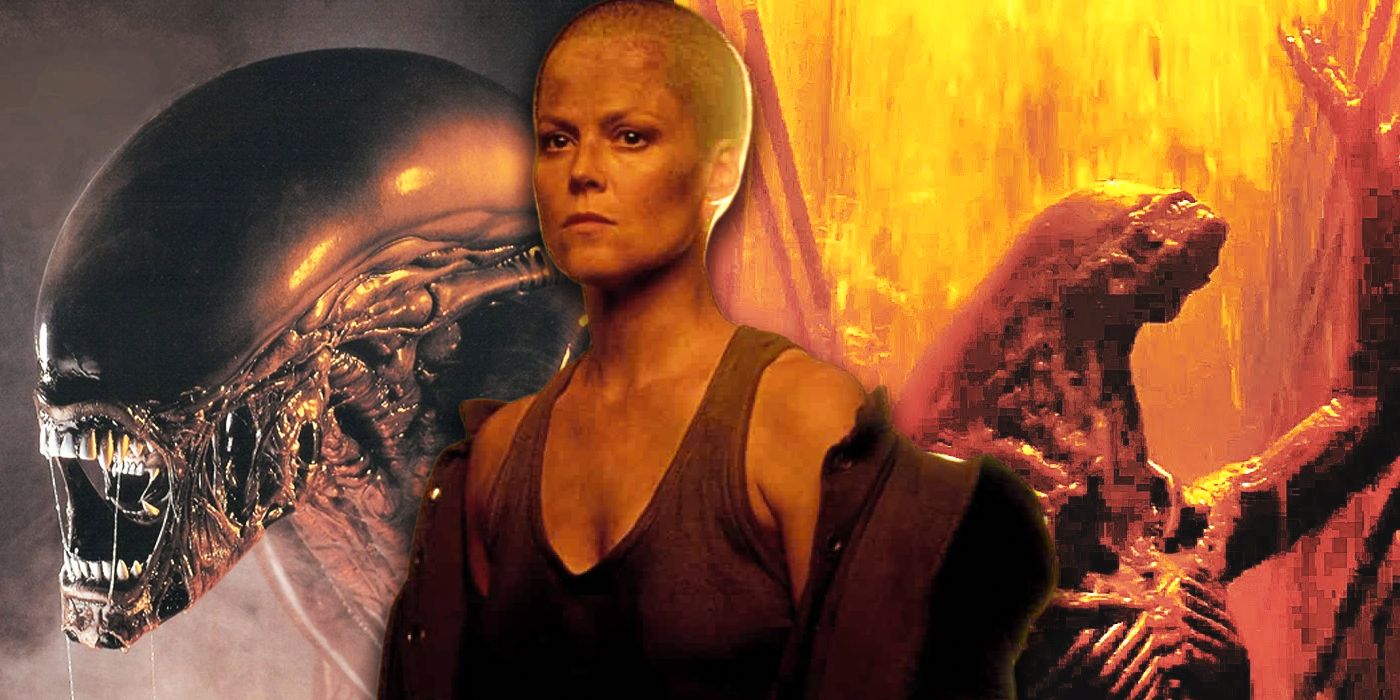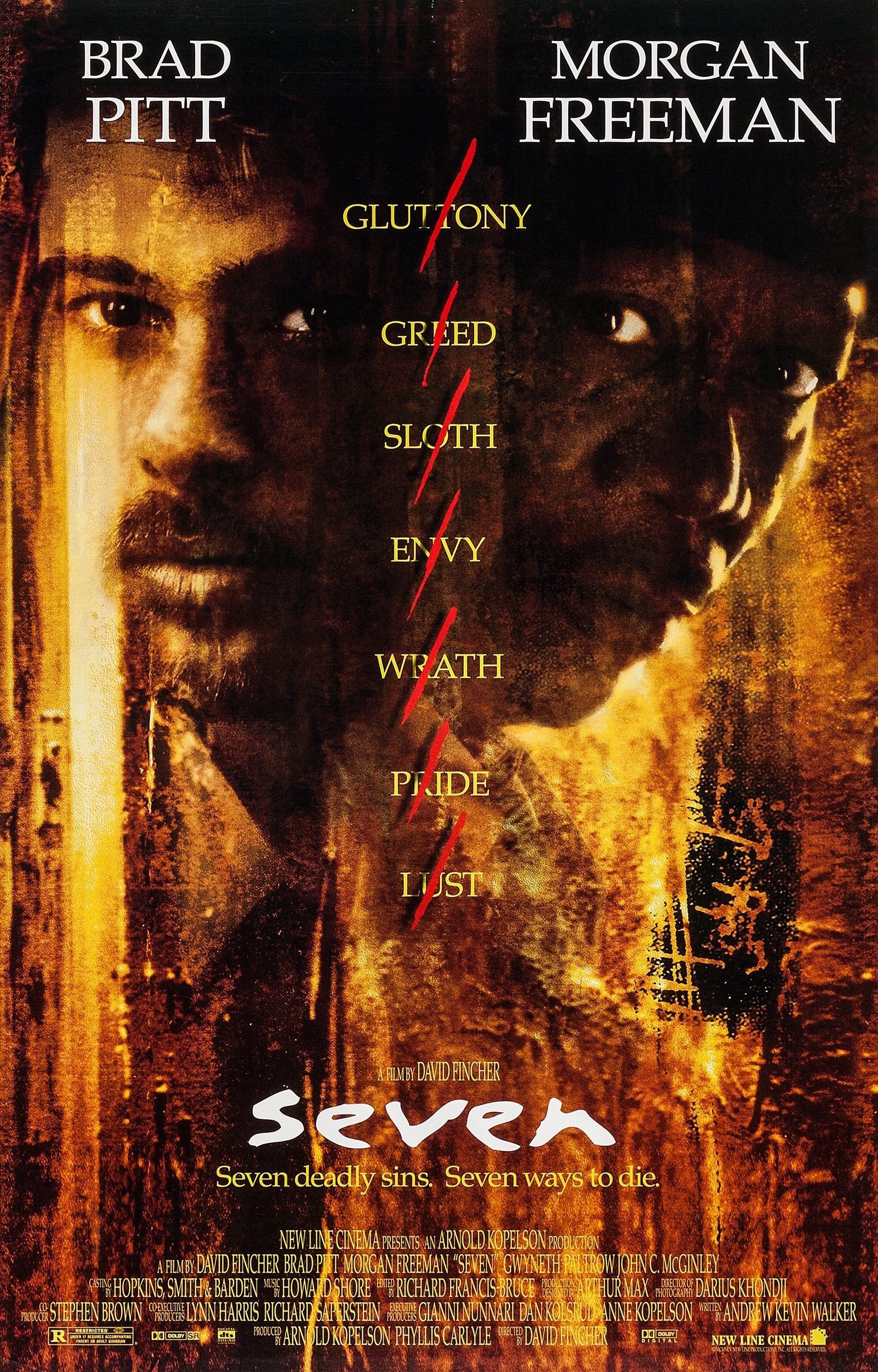The following contains spoilers for Se7en. Proceed with caution.
Today and despite one of its star’s falls from grace, Se7en is rightly considered to be one of the best crime movies ever made. Directed by David Fincher and written by Andrew Kevin Walker, Se7en was so good and groundbreaking that it redefined what Neo Noir movies and serial killer stories should be in a decade when hard-boiled fiction was suffering from oversaturation. The movie’s famously nihilistic ending cemented its legacy, but believe it or not, Se7en almost had a happier but worse conclusion.
As the story goes, Fincher signed up to helm Se7en because he was so impressed by Walker’s dark script. This, despite claiming he’d never direct a movie again following his horrible experience with Alien 3. However, New Line Cinema actually sent him Walker’s original draft. They then sent the director the updated script, which featured a happier ending. Fincher, Walker and even the principal cast hated the updated version, and had to fight for the grim but superior Se7en that moviegoers know and love today.
Se7en Almost Ended With an Action-Packed Finale in a Burning Church
The Movie Was Saved From Mediocrity by the Producers’ Honest Mistake
Se7en’s climax has Detectives William Somerset (Morgan Freeman) and David Mills (Brad Pitt) finally capturing the serial killer John Doe (Kevin Spacey), but unknowingly falling right into his trap. John promises to bring the detectives to the location of the last two victims of his killing spree themed after the Seven Deadly Sins as outlined in the Bible. Instead of finding two victims themed after Envy and Wrath, the detectives realize that John sees himself as Envy, while Mills represents Wrath. John planned to turn Mills into Wrath by gifting the detective Tracy’s (Gwyneth Paltrow), Mills’ pregnant wife, severed head in a box. Despite Somerset’s desperate pleas, Mills shoots John dead, completing the monster’s plans and letting him escape justice. Se7en ends with Mills being arrested, but with his fellow police officers swearing to keep an eye out for him. Impressively, Somerset’s conviction to keep fighting for an imperfect and even cruel world was only strengthened after he saw humanity’s darkest recesses firsthand.
Naturally, with an ending this bleak, it’s not too surprising to learn that New Line Cinema wanted something more upbeat and palatable. In fact, the epilogue with the police promising Somerset that they’d help Mills and Somerset quoting Ernest Hemingway were compromises that Fincher agreed to after the fact. If Fincher and Walker had their way, Se7en would’ve ended by smashing to black and credits after Mills executed John. Producers wanted an ending that wasn’t too abrupt and a little more reassuring, hence the epilogue’s addition. For what it’s worth, this coda gave the movie a more definite conclusion, plus a much-needed glimmer of hope and humanity in such a dark story. Thankfully, this was the only major change that the cast and crew were willing to make. This was because, in Walker’s revised script, Tracy survived, and her head was never in the box.
The rewritten Se7en had Somerset and Mills confronting John in an abandoned church. Here, John was revealed to have been abused by the priest who ran the orphanage John grew up in. His Biblical-themed murders were part of his elaborate revenge against religion and the world. In this version of the movie, John kills a captured Mills, Somerset overpowers John but then leaves him to burn in the church, and Tracy leaves the city to raise hers and Mills’ child alone. The script then ended with Mills’ funeral. This version of Se7en aligned perfectly with the movie’s religious themes, but compared to the final cut’s sublime morality play, it was incredibly blunt and heavy-handed.

Related
‘That Became My Edict’: David Fincher Reveals 1 Big Lesson He Learned From Alien 3’s Failure
Alien 3 was the wake-up call that changed David Fincher’s career.
It’s worth noting that this rewrite was finished before Fincher signed on, and back when the movie was going to be directed by Jeremiah S. Chechik. This more conventional climax was presumably part of the script that New Line Cinema thought they sent to Fincher. After reading Se7en as Walker intended it to be, every major name attached to the movie rejected the rewrite when producers tried to fix their mistake. Given how the movie is a pessimistic and even spiteful look at the futility of good in the face of evil’s overpowering might, it goes without saying that this safer ending ruined Se7en’s entire point — and Fincher, Walker and Pitt knew this.
As the actor recounted during an interview with Entertainment Weekly, Pitt had to contractually demand that Tracy die, and that his character kill John. If neither of his demands were met, he would’ve walked out, thus denying Se7en of his star power and name recall.
Brad Pitt: I said, “I will do [Se7en] on one condition — the head stays in the box. Put in the contract that the head stays in the box.” Actually, there was a second thing, too: “[Detective David Mills has] got to shoot [John Doe] in the end. He doesn’t do the ‘right’ thing, he does the thing of passion.”
Similarly, Fincher signed on to direct Se7en because he wanted to film Walker’s vision. Michael de Luca, New Line Cinema’s head of production at the time, backed up Fincher at every turn. At most, Fincher agreed to a few key compromises. These included the aforementioned epilogue, and never actually showing Tracy’s severed head onscreen to appease producer Arnold Kopelson. That said, the only thing more morbidly fascinating than ending the methodical Se7en with a fiery finale was that this was only one of 13 possible final acts that the movie could’ve had. Walker wrote 13 drafts based on studio notes, and while not all these alternate endings may ever see the light of day, it’s safe to assume that they all range from predictable to downright atrocious.
Se7en Had More Than One Terrible Alternate Ending
The Movie’s Alternate Endings Clashed With Its Inherent Darkness and Overall Message
Including Fincher’s original abrupt ending, the stand-off in a literal Biblical inferno, and a less tense edit of the final cut’s conclusion, Se7en currently (and fittingly) has seven known alternative endings. For one, Se7en’s second-most well-known rewrite ended with Somerset and Mills racing against the clock to save a kidnapped Tracy from John. A shootout ensues, Tracy is rescued, and the detectives save the day. Producers toyed with this very mainstream conclusion as a potential alternative to Walker’s original ending, but it was shut down almost immediately. Not only was this formulaic by thrillers’ standards, but it contradicted everything that came beforehand. Se7en was a look into humanity’s darkness; not a simple battle between heroes and villains. Additionally, this ending was a better fit for a bombastic cop movie starring someone like Arnold Schwarzenegger or Sylvester Stallone, not a methodical one that owed more to classic Film Noir than contemporary blockbusters.
Another version followed Se7en’s final cut all the way to the climax, only this time ending with Somerset killing John. In doing so, Somerset sacrificed his career to give Mills (and the younger generation) another chance, while also finally standing up against the world’s evils instead of just passively observing them. This ending also gave an emotional payoff to Somerset’s bond with Tracy, since she revealed her pregnancy to him and asked him to keep it a secret from Mills for the time being. Unsurprisingly, Freeman liked this climax after he saw it on the storyboards. Unfortunately for the veteran actor, his preference was overruled when Fincher agreed with Pitt that Mills had to be the one to kill John, and that John deserved to have the last laugh.
In another take on the movie’s climax, Mills shoots Somerset after the latter tries to stop him from executing John. Somerset draws his switchblade in a futile attempt to get Mills to stand down, Mills shoots Somerset, kills John, and makes a run for it. This version of Se7en ends with Somerset recovering in a hospital and reading an apologetic letter from Mills, who’s now presumably a wanted fugitive. The most interesting thing about this rewrite is that it actually utilized Somerset’s switchblade for more than just opening the infamous box, despite the knife being teased throughout the movie. Said switchblade has since become one of cinema’s most famous Red Herrings.

Related
Denzel Washington Says He ‘Blew It’ by Turning Down This $327 Million Thriller (& He’s Right)
30 years after the premiere of Se7en, one of Hollywood’s greatest actors is still reflecting on his near-involvement with the film.
Stranger versions of Se7en’s ending didn’t go beyond some odd studio notes, but they’re still so baffling that they deserve to be mentioned. According to Pitt in the same interview with Entertainment Weekly, executives at one point suggested that Tracy’s head be replaced by that of Mills’ pet dog, or the head of a woman who just so happened to look a lot like Tracy. How these would’ve tied into Se7en’s grim morality and religious subtext has yet to be explained. Worse, these possible changes reduced John from being the embodiment of evil as described in the Bible to a cruel joker who essentially tried to prank Mills into committing cold-blooded murder. Thankfully, these horrible suggestions were quickly shut down by Fincher and crew.
While the producers’ concerns weren’t exactly wrong or unfounded, their “fixes” would’ve resulted in a safer but less interesting and more forgettable movie. If they had their way, Se7en would’ve been lost in the glut of hard-boiled crime stories made in the ’90s instead of being a singular force that codified its own tropes and subgenre. The fact that almost every contemporary serial killer story still draws influence from Se7en is a testament to how great Walker’s original vision was from the very beginning. Each of these alternate endings would’ve been great in any other movie, but they would’ve unquestionably ruined Se7en.
It’s also not hyperbolic to say that Fincher’s famously dark and meticulous style was born in this movie, and he’s been refining it ever since. The fact that Se7en only exists thanks to a clerical error is one of the greatest strokes of luck and happiest accidents in film history. Given its undying legacy and the enduring power of Pitt breaking down while demanding to know what was in the box, the cast’s and crew’s fight for Se7en’s true ending was right and vindicated.
Se7en is now available to watch and own physically and digitally.

Two detectives, a rookie and a veteran, hunt a serial killer who uses the seven deadly sins as his motives.
- Release Date
-
September 22, 1995
- Director
-
David Fincher
- Cast
-
Brad Pitt
, Gwyneth Paltrow
, John C. McGinley
, Morgan Freeman
, Kevin Spacey - Runtime
-
127 minutes








